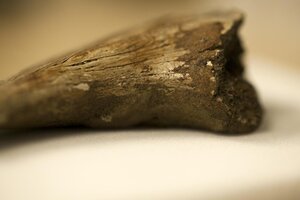Fossilized dinosaur blood? Blood cells found in 75-million-year-old bones.
Fossilized dinosaur blood: Researchers from Imperial College London have discovered what appears to be soft tissue in otherwise unremarkable bone fragments.

Ungual claw from indeterminate theropod where the erythrocyte-like structures were found.
Courtesy of Laurent Mekul
Could overlooked dinosaur bones hold the key to Jurassic Park?
Upon analyzing a set of seemingly unremarkable fossil fragments, a team of British paleontologists found something highly unusual. Red blood cells and collagen, which by all rights ought to have decomposed millions of years ago, appeared to be preserved in 75-million-year-old bone. If verified, the findings, which were announced Tuesday in the online scientific journal Nature Communications, could offer new leads as paleontologists seek a greater understanding of dinosaur biology.
The discovery of soft tissue from dinosaurs isn’t unheard of. Flexible fibers and “proteinaceous” material have been found in the bones of Cretaceous dinosaurs like Tyrannosaurus rex, and fossilized Eocene mosquitos occasionally carry dinosaur hemoglobin. But in each of these cases, the specimen was singularly well preserved.
The eight fossil fragments analyzed by Susannah Maidment and Sergio Bertazzo were not. The bones, some of which may have belonged to a Late Cretaceous predator called Gorgosaurus, had been housed in the Natural History Museum of London for over a century. Incomplete and poorly preserved, they didn’t generate much attention. But with a focused ion beam and high-tech microscopes, Dr. Maidment and Dr. Bertazzo found hidden promise in the bones – microscopic structures that looked a lot like soft tissue.
One isolated claw contained apparent erythrocytes, or red blood cells, complete with nuclei. For reference, researchers also imaged the red blood cells of emus – large, flightless birds that are skeletally similar to many two-legged dinosaurs. They found that both samples fit similar profiles. In other fragments from the collection, they found traces of collagen, a structural protein found in connective tissue.
But for the time being, dino cloning is still out of the question. Even though some cellular components seem to be preserved, Maidment and Bertazzo didn’t find any DNA in their samples.
“But even if one was to find some fragments of DNA, we would not be able to reconstruct a dinosaur ‘Jurassic Park-style’ because we would need the complete genome to figure out where the holes in the DNA are,” Maidment told Reuters.
But these findings could change how paleontologists understand fossil preservation. It was once thought that proteins decayed completely in a window of about 4 million years. But new evidence suggests that scores of nondescript dinosaur bones, just like the ones described by Maidment, could contain similar biological evidence.
“Early indications suggest that these poorly preserved fossils may be useful pieces in the dinosaur jigsaw puzzle to help us to understand in more detail how dinosaurs evolved into being warm blooded creatures, and how different dinosaur species were related,” Maidment said in a press release.

